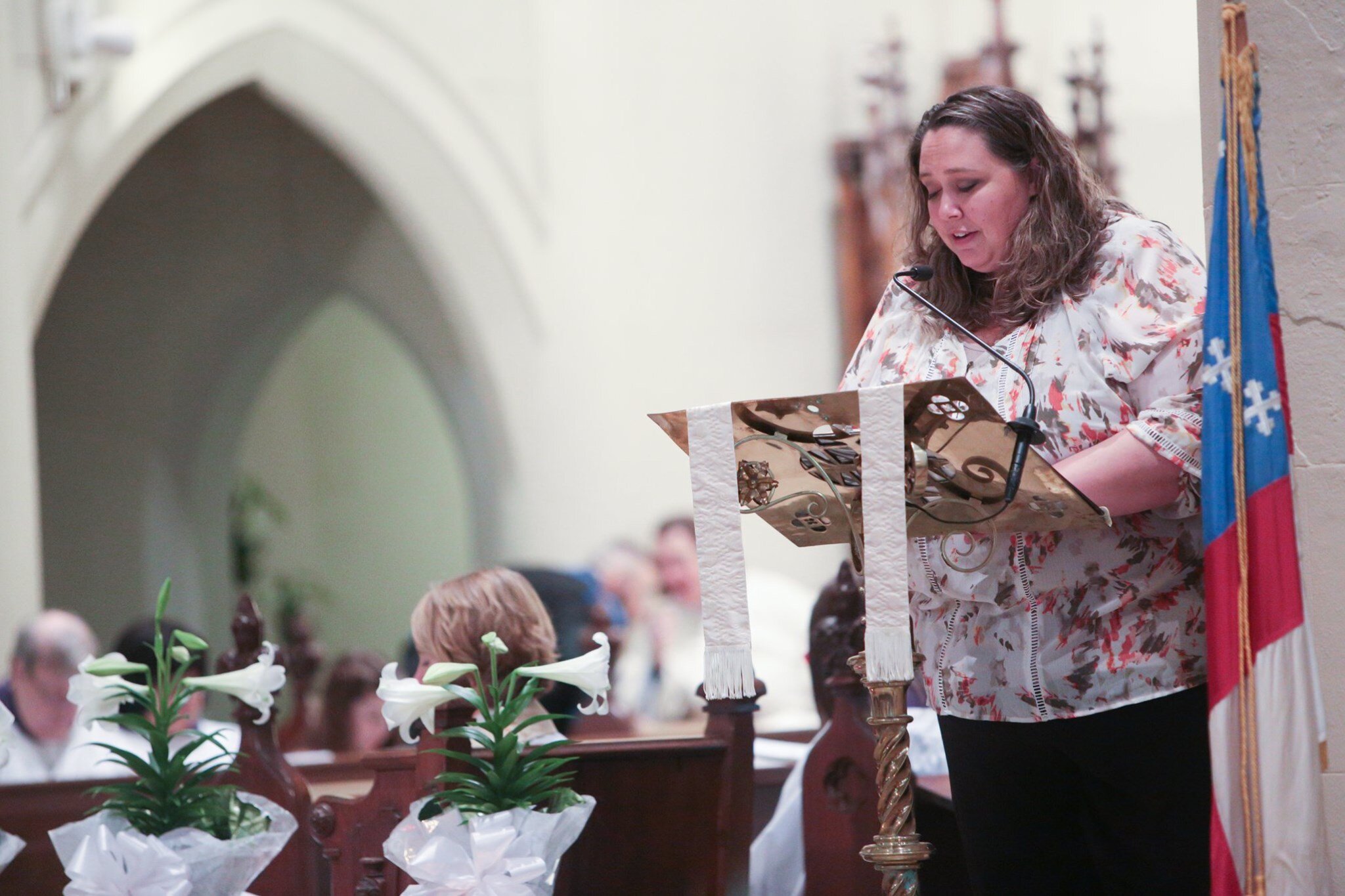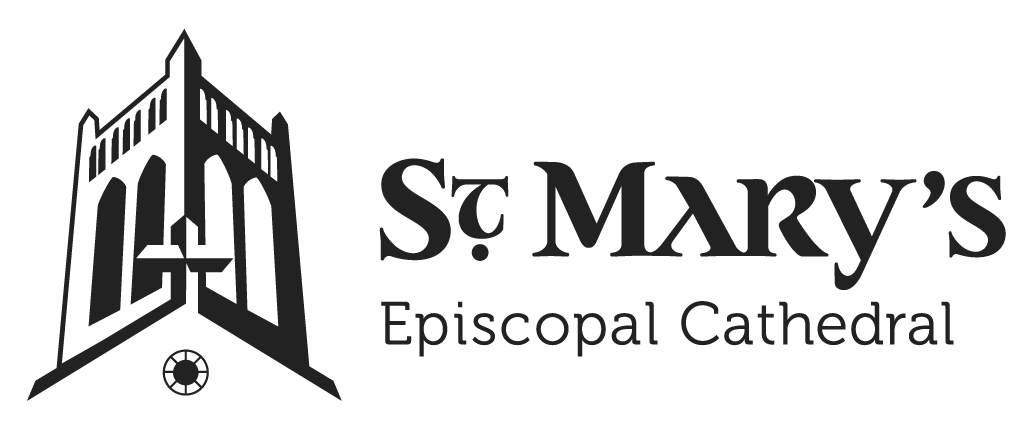
New to St. Mary’s?
Advice for your first visit to St. Mary’s
When visitors come into a cathedral, they enter a world that reaches the depths of our spiritual tradition and ascends to God's generosity and hospitality. A cathedral is a sign of our call to be inclusive and compassionate to the whole human family. God loves everyone without exception or reservation. We encourage you to open yourself to be blessed by beauty, community, Holy Scripture, and Christ's sacraments.
Look for beauty and grace everywhere. The St. Mary’s Episcopal Cathedral is built in the shape of a Latin cross, with a high vaulted ceiling that expresses the vast goodness and benevolent mystery of God.
The worship space is adorned with old stained glass that tells the salvation history of God working through Christ. The music here is heavenly alive and celebratory. The people who fill the space are the most beautiful of all—individuals and families from all socio-economic backgrounds, skin tones, and orientations seeking the Divine together.
When you come to be with us, please expect to be moved. St. Mary’s is a holy place. We believe in one God, known to us through Jesus Christ and the ever-present Holy Spirit.
We seek to challenge and transform the world, beginning with ourselves, and to celebrate the image of God in every person. We are steeped in the heritage of the Episcopal Church walking along a via media or “middle way” between Roman Catholic and Reformed/Protestant traditions.
We worship in the ancient way, through listening and sharing the Word of God, along with sharing the sacraments by celebrating the Holy Eucharist (The Lord's Supper) most every time we gather.
Come, live and serve with us as we continue the ministry Jesus began so long ago—to relieve the suffering and mend God’s beautiful but bruised creation.

What to Expect
How Episcopalians worship: Like most Christian churches from both the Protestant and Catholic traditions, Sunday is traditionally when Episcopalians gather for worship. St. Mary’s principal weekly worship service is our “Holy Eucharist.”
The term “eucharist” technically refers to that principal act of Christian worship also known as the Lord’s Supper or Holy Communion. But we also call our entire worship service a “eucharist.” It begins with a dramatic entrance rite, where the choir, priests, and others walk in procession to the front of the Cathedral while the congregation sings a hymn. This is followed by prayers, Bible readings, and a sermon. The second portion of the service is the actual communion rite, followed by concluding prayers of thanksgiving and dismissal.
Worship Styles
Book of Common Prayer
Episcopalians worship in many different styles, ranging from very formal, ancient, and multi-sensory rites with lots of singing, music, fancy clothes (called vestments), and incense, to informal services with contemporary music. St. Mary’s Sunday worship style leans toward the formal, without losing sight of the real meaning behind our traditions and how they relate to the modern world. All worship in the Episcopal Church is based in the Book of Common Prayer, which gives worship a familiar feel, no matter where you go (those are the red books in the pew rack).
Liturgy and ritual at St. Mary’s Episcopal Cathedral, or “turn to the left, turn to the right, stand up, sit down, rite, rite, rite!”
Worship in the Episcopal Church is said to be “liturgical,” meaning that the congregation follows service forms and prays from texts that don’t change greatly from week to week during a season of the year. This sameness from week to week gives worship a rhythm that becomes comforting and familiar to the worshipers.
For the first-time visitor, liturgy may be exhilarating—or confusing. Services may involve standing, sitting, kneeling, sung or spoken responses, and other participatory elements that may provide a challenge for the first-time visitor. Liturgical worship, however, can be compared with a dance: once you learn the steps, you come to appreciate the rhythm, and it becomes satisfying to dance, again and again, as the music changes.
The Holy Eucharist
While there is a diversity of worship styles in the Episcopal Church, Holy Eucharist always has the same components and the same shape:
The Liturgy of the Word:
We begin by praising God through song and prayer. We then listen to as many as four readings from the Bible, usually one from the Old Testament, a Psalm, something from the Epistles, and (always) a reading from the Gospels. The psalm is usually sung or recited by the congregation.
Next, a sermon interpreting the readings appointed for the day is preached.
The congregation then recites the Nicene Creed, written in the Fourth Century and the Church’s statement of what we have believed ever since.
Next, the congregation prays together—for the Church, the World, and those in need. We pray for the sick, thank God for all the good things in our lives, and finally, we pray for the dead. The presider or “celebrant,” usually our dean, our bishop or another priest, concludes with a prayer that gathers the petitions into a communal offering of intercession.
In certain seasons of the Church year, the congregation formally confesses their sins before God and one another. This is a corporate statement of “what we have done and what we have left undone,” followed by a pronouncement of absolution. In pronouncing absolution, the celebrant assures the congregation that God is always ready to forgive our sins.
The congregation then greets one another with a sign of “peace,” usually accompanied by hand-shaking, hugs, and a lot of 10-second catch-up conversations.

The Liturgy of the Table (Communion):
Next, the priest stands at the table, which has been set with a cup of wine and a plate of bread or wafers, raises his or her hands, and greets the congregation again, saying “The Lord be With You.” Now begins the Eucharistic Prayer, in which the celebrant tells the story of our faith, from the beginning of Creation, through the choosing of Israel to be God’s people, through our continual turning away from God, and God’s calling us to return. Finally, the celebrant tells the story of the coming of Jesus Christ, and about the night before his death, on which he instituted the Eucharistic meal (communion) as a continual remembrance of him.
The celebrant blesses the bread and wine, and the congregation recites the Lord’s Prayer. Finally, the celebrant breaks the bread and offers it to the congregation, as the “gifts of God for the People of God.”
The congregation then shares the consecrated bread and the wine. Sometimes, the people all come forward to receive the bread and wine; sometimes they pass the elements around in other ways.
All are welcome to participate!
All baptized Christians—no matter age or denomination—are welcome to “receive communion.” Episcopalians invite all baptized people to receive, not because we take the Eucharist lightly, but because we take our baptism so seriously.
Visitors who are not baptized Christians are welcome to come forward during the Communion to receive a blessing from the celebrant.
At the end of the Eucharist, the congregation prays once more in thanksgiving, and then is dismissed to continue the life of service to God and to the World. (But first, we drink coffee and eat great food in the Parish Hall for a bit.)





